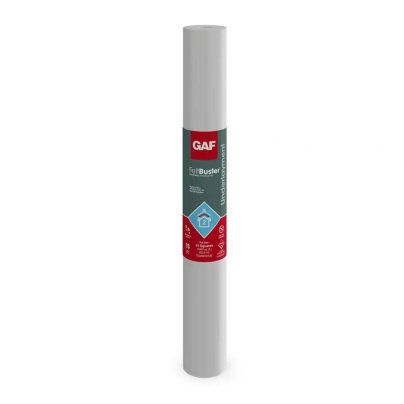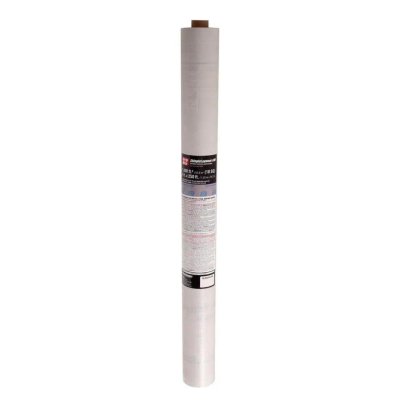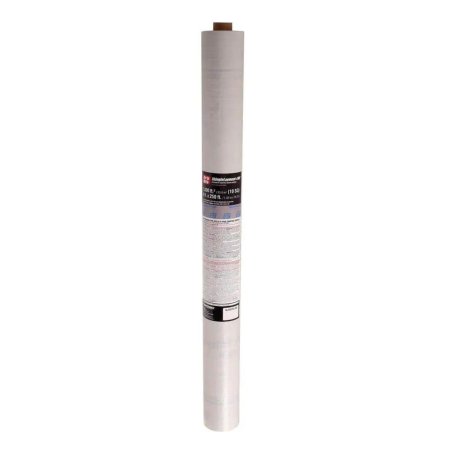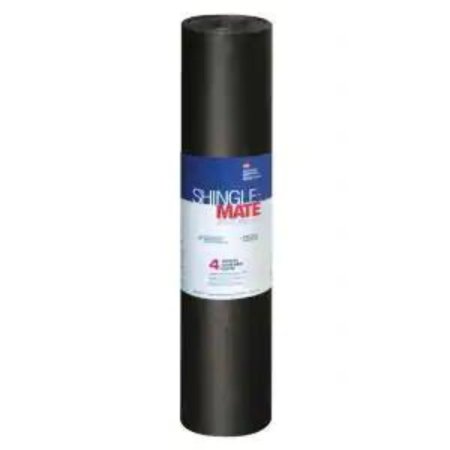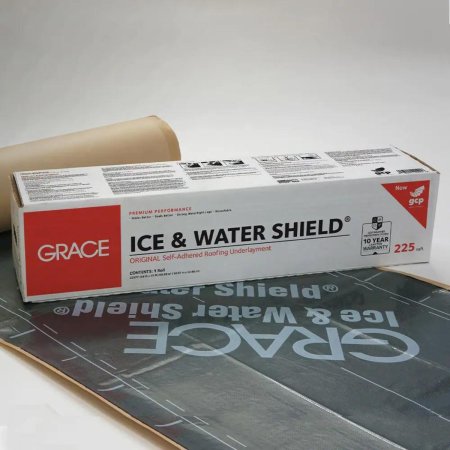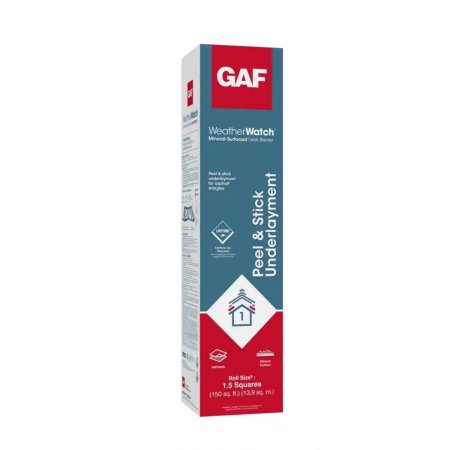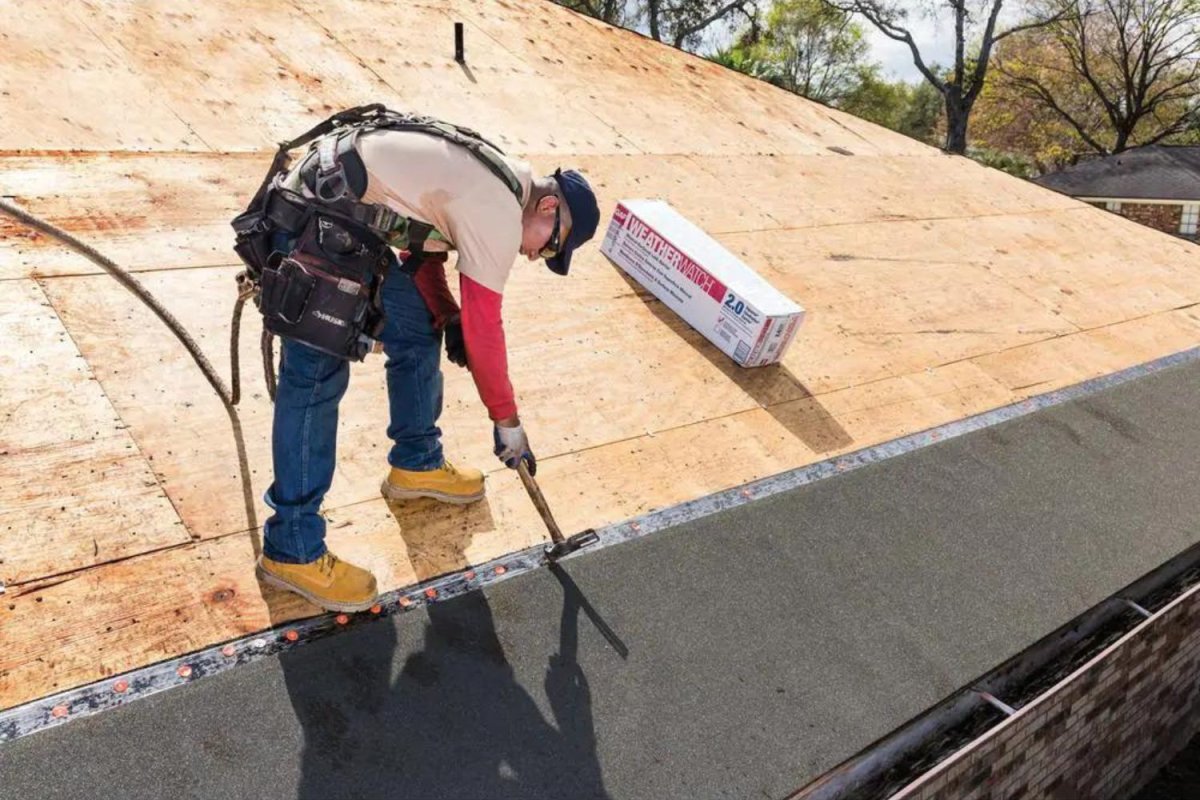
We may earn revenue from the products available on this page and participate in affiliate programs. Learn More ›
From the ground, a roof looks like a simple set of inclined planes meant to shed water. However, roofs are actually complex systems of shingles, plywood, different types of flashing, membranes, vents, sealant, and more. Underneath it all sits one of the most important components of the system: the roofing underlayment.
Roofing underlayment serves many purposes. It protects the plywood decking from the elements, helping shed moisture and prevent leaks while also maintaining a barrier between the roofing material and decking. This guide will explain how to choose and what to look for in the best roof underlayments.
- BEST OVERALL: Gaf FeltBuster Synthetic Roofing Felt
- BEST BANG FOR THE BUCK: Grip-Rite ShingleLayment-15 GRE Roofing Underlayment
- UPGRADE PICK: GCP Grace Ice & Water Shield HT
- BEST FELT: Warrior Roofing 30W Roofing Felt
- BEST RUBBERIZED: GCP Grace Ice & Water Shield
- BEST SYNTHETIC: Owens Corning ProArmor Synthetic Roof Underlayment
- ALSO CONSIDER: Gaf WeatherWatch Ice & Water Leak Barrier
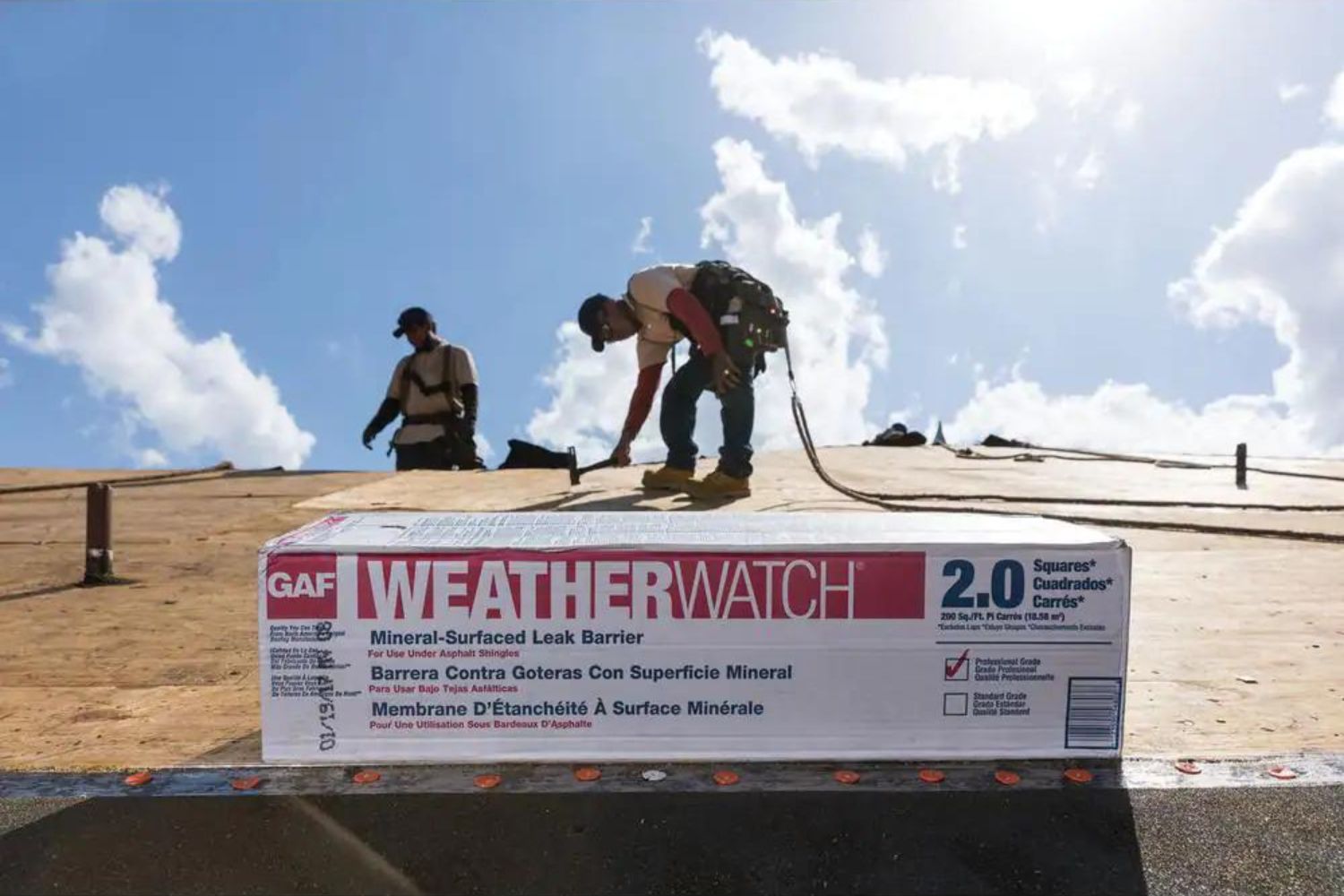
Types of Roof Underlayments
There are essentially three types of roof underlayments: felt, rubberized, and synthetic. Each has its pros and cons, and there are certain situations in which one may excel over the others.
Felt
Felt roofing underlayment, also known as felt paper, is the old-school version of roofing underlayment. These thick, heavy rolls of felt include combinations of polyester and natural plant fibers soaked in bitumen (commonly known as asphalt). They’re generally inexpensive compared with other materials, and they come in lighter-weight (15 pound) or heavy-duty (30 pound) varieties.
Though felt is more affordable, it’s important to understand its drawbacks. First, it’s very heavy and difficult to lift onto a roof, so it comes in much shorter rolls than other materials. Also, felt paper isn’t very tear-resistant, so shingles need to be installed immediately to avoid damage from the elements.
Rubberized
Rubberized roofing underlayment is a different animal. These products are essentially peel-and-stick rubber membranes that roofing installers can apply directly to the roofing deck. One side of the membrane is smooth while the other has a sticky substance known as butyl.
Rubberized roofing membrane is highly adhesive and creates a waterproof barrier over the roofing deck. It’s the best material for preventing leaks from ice dams and other weather events, and many installers use rubberized underlayment in conjunction with synthetic or felt products.
Synthetic
Synthetic underlayment is quickly growing in popularity. These lightweight sheets made of woven or spun synthetic fibers (polyethylene or polypropylene) provide a durable, weather-resistant barrier that is easy to apply and often includes shingle or nailing patterns printed on their faces.
Because synthetic roofing underlayments are so lightweight, manufacturers can offer more square footage per roll. They’re more expensive, but the faster coverage that synthetic underlayments offer because of their size can be a big boost in production. Also, because the fibers that make up synthetic underlayments are so durable, they don’t need to be covered nearly as soon as felt does.
What to Consider When Choosing the Best Roof Underlayment
Before settling on the materials for a roofing project, there are quite a few considerations to keep in mind. The following sections include some of the most important points to think about when choosing the best roofing underlayment.
Roof Type
Roofing type can play a role in choosing the best roofing underlayment. Certain materials such as asphalt shingles, metal roofing, or slate might require a specific type of underlayment over another.
Though it’s always best to check with the manufacturer’s instructions before deciding on an underlayment, the following may be some helpful guidelines:
- Asphalt shingles: Almost all underlayment types are suitable for asphalt shingles.
- Metal roofing: The expansion and contraction of metal roofing panels can wear down synthetic or felt underlayment. Rubberized underlayments are best for these roofs.
- Slate and tile roofs: For these classic or traditional roofing materials, many manufacturers recommend heavy-duty #30 (30-pound) felt paper as the underlayment material.
Climate
The climate in which a home was built may determine which underlayment material to choose. For instance, in colder climates where snow and ice are prevalent, rubberized underlayment is the most effective at preventing leaks. Rubberized underlayment is also best for extremely high temperatures. Synthetic underlayment is better all-around than felt, allowing humidity to escape while preventing water penetration, but both will do well in mild climates.
Keep in mind that fire resistance also matters, particularly to those in drier climates prone to wildfires. For the best protection, look for underlayments that are Class A certified to pair with fire-resistant shingles or other roofing materials.
Installation
The installation process between the three roofing underlayment types does vary a bit, and it could be a determining factor for certain DIYers.
Felt paper is very heavy, so manufacturers typically sell it in 3-foot-wide rolls (1 foot less than most synthetic underlayments). This means less coverage per roll and more trips up and down a ladder. Once the felt paper is unrolled, users staple it to the deck surface. They must also be careful, as the felt can rip and cause a fall hazard.
Synthetic roofing underlayment is much easier to install than felt. It’s lighter and comes in wider rolls, meaning more coverage with less work. However, it typically requires capped nails for installation, which are more expensive and require more effort to apply than staples. And though the original synthetic underlayments were slippery, today’s versions are actually slightly tacky, providing better footing.
Rubberized roofing underlayment can be a hassle to install. These rolls are heavy and don’t offer much coverage. The user has to lay the material out on the roof surface, cut it, and then remove the paper backing from the adhesive before sticking it to the deck surface. The tacky butyl will often stick to itself and become very difficult to separate. However, once cut and stuck to the roof, the user must simply smooth the surface, with no need for nails or staples.
Tip: Apply rubberized underlayment in colder temperatures (about 40 degrees Fahrenheit) to make it as easy as possible to work with.
Our Top Picks
That’s a lot of background on the best roofing underlayments, but choosing just one product can still seem overwhelming. To help, check out some of the following top products on the market.
Best Overall
Gaf FeltBuster Synthetic Roofing Felt
Pros
- Lightweight and durable polypropylene construction
- Provides traction for safety
- Nailing pattern on the front
- Class A fire-resistant
Cons
- Slightly expensive compared to some other synthetics
Product Specs
- Type: Synthetic
- Size: 250 feet long by 4 feet wide
- Fire rating: Class A
Folks looking for an all-around capable roof underlayment should consider the Gaf FeltBuster synthetic roofing underlayment. Despite the name, this product is all synthetic, designed to be tough enough to withstand the weather and lightweight enough for easy carrying up and down a ladder.
This synthetic roofing underlayment comes in rolls measuring 250 feet long by 4 feet wide, allowing for up to 1,000 square feet of coverage. There is a handy nailing pattern on the face for accurate placement of nails, and the material provides more traction than asphalt underlayment for safer working conditions. The polypropylene material is Class A fire-resistant and lays flat on overlapped sections, promoting a more even, consistent look when the roof is finished. It is slightly expensive, but it may be worth the investment.
Get the GAF FeltBuster roof underlayment at The Home Depot.
Best Bang for the Buck
Grip-Rite ShingleLayment-15 GRE Roofing Underlayment
Pros
- Affordable price point compared with other synthetics
- Nailing, overlap, and shingle guides for easier installation
- Slip-resistant surface for safety
Cons
- Not rated for fire resistance
Product Specs
- Type: Synthetic
- Size: 250 feet long by 4 feet wide
- Fire rating: None
Those who want to protect their investment in their roof without breaking the bank should consider ShingleLayment roof underlayment from Grip-Rite. This affordable underlayment comes in rolls 250 feet long by 4 feet wide, allowing users to cover their roofing decks for less than most other synthetic products.
ShingleLayment is made of polypropylene, giving this synthetic underlayment plenty of strength and durability against the elements. It features a nailing pattern for the capped nails and overlap, promoting a cleaner installation for better water resistance. Also, the shingle pattern printed on the front makes lining up courses of shingles easier and more accurate. Not only is this roll affordable, it’s also slip-resistant. Unfortunately, it’s not rated for fire resistance.
Get the Grip-Rite roof underlayment at The Home Depot.
Upgrade Pick
GCP Grace Ice & Water Shield HT
Pros
- Peel-and-stick application
- Creates a watertight seal
- HT formula is suitable for the hottest roofs
- Class A rated
Cons
- It’s expensive
Product Specs
- Type: Rubberized
- Size: 75 feet long by 3 feet wide
- Fire rating: Class A
DIY roofers looking for the ultimate roofing protection will want to consider GCP Grace Ice & Water Shield HT roof underlayment. This rubberized underlayment features a peel-and-stick application process that doesn’t require any fasteners and creates a durable, watertight seal. It comes in rolls measuring 75 feet long by 3 feet wide and features a Class A fire rating.
The HT in the product name stands for High Temperature, and it indicates that this rubberized membrane is suitable for application on the hottest of roofs. It’s also suitable for roofing materials of all types. It is fairly expensive, especially considering the rolls don’t offer much coverage, but there is plenty of value for the level of protection.
Get the GCP HT roof underlayment at The Home Depot or on Amazon.
Best Felt
Warrior Roofing 30W Roofing Felt
Pros
- Heavy-duty felt heavily saturated with asphalt
- Suitable for use under slate and tile shingles
- Class A fire rating
- Promotes traction
Cons
- Expensive from a square-foot perspective
Product Specs
- Type: Felt
- Size: 72 feet long by 3 feet wide
- Fire rating: Class A
If felt roofing paper is on the table, Warrior Roofing’s 30W roofing overlayment is worth considering. This 30-pound felt underlayment is made of thick, durable felt that’s heavily soaked in asphalt. This combination creates an underlayment that lays flat and resists water.
This Warrior Roofing underlayment comes in rolls measuring 72 feet long by 3 feet wide, providing up to 216 square feet of coverage. It’s suitable for shingle, slate, and tile roofs. It carries a Class A fire rating and promotes traction for safety. Although the cost per roll isn’t much, note that the coverage is low, making most synthetic rolls a bit more affordable in the long run.
Get the Warrior Roofing roof underlayment at The Home Depot.
Best Rubberized
GCP Grace Ice & Water Shield
Pros
- Watertight seal unmatched by felt or synthetic underlayments
- Split-release paper solves some challenges during application
- Moves with the expansion and contraction of a metal roof
Cons
- Expensive underlayment option
Product Specs
- Type: Rubberized
- Size: 75 feet long by 3 feet wide
- Fire rating: Class A
If someone is looking for peace of mind for their next roofing project, GCP’s Grace Ice & Water Shield might be the best product for the job. This rubberized roof underlayment adheres directly to the decking, creating a watertight seal that synthetic and felt products can’t match.
Grace Ice & Water Shield comes in rolls measuring 75 feet long by 3 feet wide for 225 square feet of coverage. It carries a Class A fire rating, and it’s suitable for any roofing material, especially metal roofs that experience expansion and contraction. The split-release paper on the back does help with some of the challenges experienced with rubberized roofing underlayments as well. This product is expensive, but the insurance Grace Ice & Water Shield can offer may be worth it.
Get the Grace roof underlayment at The Home Depot or Lowe’s.
Best Synthetic
Owens Corning ProArmor Synthetic Roof Underlayment
Pros
- Fusion Back Coating to promote traction
- Suitable for asphalt and metal roofs
- Class A fire rating
- Resists stretching and tearing
Cons
- Will require more courses than a 4-foot roll
Product Specs
- Type: Synthetic
- Size: 286 feet long by 42 inches wide
- Fire rating: Class A
When synthetic is the underlayment material of choice, shoppers will want to consider Owens Corning’s ProArmor roof underlayment. This product’s durable polypropylene material resists stretching or ripping around fasteners but weighs just 25 pounds for easy carrying. It also features the brand’s Fusion Back Coating, promoting safer installation by offering traction to folks walking on top.
Owens Corning states that ProArmor underlayment is suitable for both asphalt and metal roofing. It comes in rolls measuring 286 feet long by 42 inches wide, providing up to 1,000 square feet of coverage, though it may require more courses to cover as much roof decking as a 4-foot roll. However, it does carry a Class A fire resistance.
Get the Owens Corning roof underlayment at Lowe’s or Menard’s.
Also Consider
Gaf WeatherWatch Ice & Water Leak Barrier
Pros
- Minerals and fiberglass on the surface for durability and traction
- Peel-and-stick application with split-back release film
- Works for entire roof or simply along the edges and problem areas
Cons
- Can be less flexible than typical rubberized underlayment
Product Specs
- Type: Rubberized
- Size: 50 feet long by 3 feet wide
- Fire rating: Class A
The Gaf WeatherWatch roof underlayment may be a smart choice for problem areas. It provides protection around areas such as valleys, dormers, skylights, and other leak-prone areas as well as roof edges. Users can apply it to the entire roof, but it’s also suitable for use in just those areas before applying a synthetic underlayment over top.
These rolls come in lengths of 50 feet, measuring 3 feet wide. The rubberized backing features peel-and-stick split-back release film, while the face contains minerals and fiberglass to promote durability and traction during application. WeatherWatch Ice & Water Leak Barrier has a Class A fire rating, but it may be slightly less flexible than other rubberized underlayments because of the minerals, meaning warm weather is typically best for installation.
Get the Gaf WeatherWatch roof underlayment at The Home Depot.
Our Verdict
Folks looking for a top-notch synthetic roofing underlayment will want to consider Gaf FeltBuster roof underlayment for its handy pattern and durable construction. However, those looking to save a bit of cash while still protecting their investment will want to consider the Grip-Rite roof underlayment.
How We Chose the Best Roof Underlayments
Choosing a list of the best roof underlayment was a lot of work. We had to draw upon all of our experience with roofing and the materials we’ve used in order to determine the most important features we felt the average DIYer would need. Then, we performed extensive product research to find options that met our criteria.
That wasn’t the end of it, though. We had to comb through all of those products and compare them based on our experience, the materials, the price, and other important factors. Products that failed to meet our standards were tossed aside, while those that passed were given awards based on their strengths.
FAQs
That’s a lot of information on roof underlayments, but there may still be some questions under the surface. The following section aims to answer those questions, as it’s a collection of some of the most frequently asked questions about roofing underlayments. Be sure to check for an answer to your question below, but if we missed it, be sure to call the underlayment’s manufacturer.
Q. Do roof shingles need an underlayment?
Yes. Although roof shingles are durable, they are only one part of a system. The rest of that system includes underlayment, flashing, drip edges, and other components designed to work together to protect the decking.
Q. How is roof underlayment installed?
It depends on the product, but roofing underlayment should be rolled parallel to the peak of the roof, starting at the lowest point first. Subsequent courses should overlap each other on the way up the peak. Staple felt paper in place or use capped nails for synthetic underlayment. Rubberized underlayment will self adhere once the backing is removed.
Q. How long does roof underlayment last?
Roofing underlayment lasts between 12 and 20 years before it starts to deteriorate. Some rubberized underlayments can last as long as 35 years.
Q. How long can roof underlayment be exposed?
Felt roofing underlayment should be covered as soon as possible. However, a few days in calm weather is usually fine. Synthetic and rubberized underlayment is typically OK for 90 days, but the sooner it’s covered, the better.
